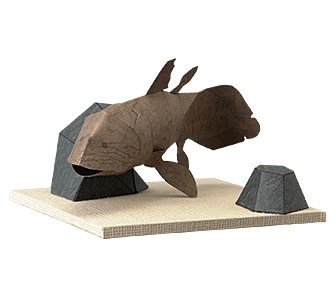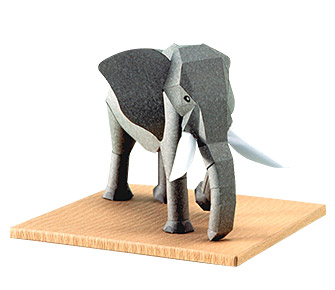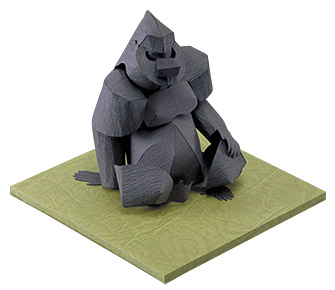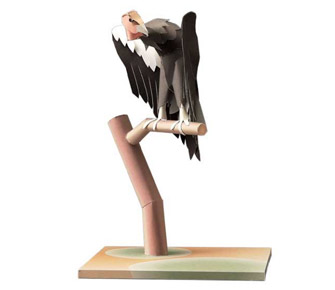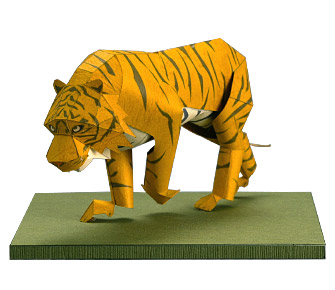California Condor
Papercraft kit : The California Condor, a predatory bird in danger of extinction.

The California condor, North America's largest raptor, is often called a “janitor” of nature due to how completely it cleans on the carcasses of dead animals.
Because of its feeding habits, the species had been hunted down as a bird of ill omen and currently suffers danger of extinction. The species is classified as “Critically Endangered [CR]” in the Red List.
Assembly instructions for the Paper Craft Model of one of the world’s rarest birds, as well as a photo image of a completed model, may be downloaded from this website.
Download - Parts sheet & InstructionsThis data was released in October, 2000.
California Condor - Animal Guide

- California Condor - Cathartidae
- Gymnogyps californianus
- 117 cm to 134 cm (approximately 3.9 ft. to 4.5 ft.) long / 300 cm (approximately 10 ft.) wing span
- 2016 Edition of the RED LIST categories : Critically Endangered [CR]
North America’s largest raptor, the California condor has a wingspan reaching approximately 3 meters (approxi. 10 ft.) as it circles in the sky riding on the wind.
The species is almost entirely covered by a sooty-black body plumage except some parts at the edge of the wings. It has no feathers from its neck upward, leaving its bare skin color visible.
The California condor, unlike the eagle or hawk, lacks strong talons for killing and carrying prey with their feet. Therefore, the species feeds almost entirely on the carrion of deer, cattle and sheep, rather than hunting for living animals. The creature’s diet indeed sounds grotesque. However, the fact is that by eating up carrion before it turns completely rotten, the California condor contributes to the preventing the spread of bacteria generated by decaying flesh. In this sense, the California condor plays the role of janitor in the natural world, cleaning up waste before it becomes unsanitary.
The condor builds its nest and raises its young on rock ledges of cliffs. A chick develops slowly, beginning to fly at about six months of age and finding its own food at around twelve months of age. During that time, the parent condor continually feeds its young.
For that reason, the reproductive rate remains low (the female lays a few eggs every two years), which makes the increase of the species very difficult.
Habitat
As its name indicates, the California condor inhabits dry hill country and mountainous areas in central California in the United States. The species widely inhabited the West Coast of North America until the beginning of the 20th century. However, because of its diet consisting solely of carrion, the condor was hunted down as a bird of ill omen, resulting in a drastic population decline. Poisonous bait placed in various areas in order to exterminate coyotes also contributed to the decline. A great number of condors that ate poisoned coyotes were killed by the same poison. Since 1974, the United States Fish and Wildlife Service has implemented preservation measures with the cooperation of private sector organization and zoos to increase the population by bringing the species into a captive breeding program and gradually began releasing the birds into the wild from 1992. Although 97 condors live in captivity and 56 condors remain in the wild as of 1999, the existence of the species still continues to be threatened.
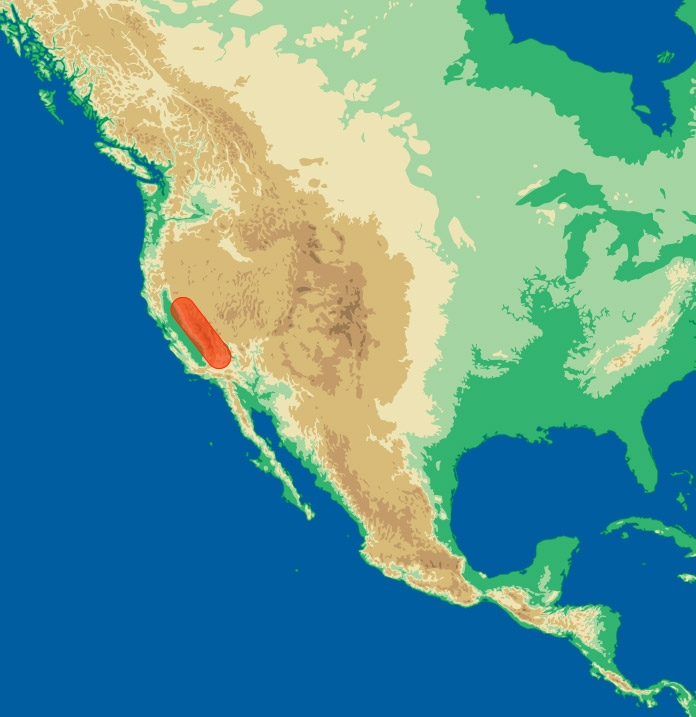
About Red List
The Red List is the material prepared by IUCN (International Union for Conservation of Nature) classifying various threatened wild animals of the world and reporting their present habitat status.
The List evaluates the extinction risk level of each individual species from a biological viewpoint, but it possesses no legal power to enforce regulations concerning threatened species. The Red List is broadly employed as fundamental information in advancing the preservation of threatened wild animals.
Referring to the original Red List, the Environment Agency of Japan has compiled the Japanese edition of the List listing threatened taxa inhabiting Japan.
| Extinct | EX | No known individuals remaining. |
|---|---|---|
| Extinct in the Wild | EW | Known only to survive in captivity, or as a naturalized population outside its historic range. |
| Critically Endangered | CR | Extremely high risk of extinction in the wild. |
| Endangered | EN | High risk of extinction in the wild. |
| Vulnerable | VU | High risk of endangerment in the wild. |
| Near Threatened | NT | Likely to become endangered in the near future. |
| Least Concern | LC | Lowest risk. Does not qualify for a more at-risk category. Widespread and abundant taxa are included in this category. |
| Data Deficient | DD | Not enough data to make an assessment of its risk of extinction. |




